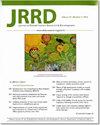Haptic feedback improves surgeons' user experience and fracture reduction in facial trauma simulation.
Q Medicine
Journal of Rehabilitation Research and Development
Pub Date : 2016-01-01
DOI:10.1682/JRRD.2015.03.0043
引用次数: 16
Abstract
Computer-assisted surgical (CAS) planning tools are available for craniofacial surgery, but are usually based on computer-aided design (CAD) tools that lack the ability to detect the collision of virtual objects (i.e., fractured bone segments). We developed a CAS system featuring a sense of touch (haptic) that enables surgeons to physically interact with individual, patient-specific anatomy and immerse in a three-dimensional virtual environment. In this study, we evaluated initial user experience with our novel system compared to an existing CAD system. Ten surgery resident trainees received a brief verbal introduction to both the haptic and CAD systems. Users simulated mandibular fracture reduction in three clinical cases within a 15 min time limit for each system and completed a questionnaire to assess their subjective experience. We compared standard landmarks and linear and angular measurements between the simulated results and the actual surgical outcome and found that haptic simulation results were not significantly different from actual postoperative outcomes. In contrast, CAD results significantly differed from both the haptic simulation and actual postoperative results. In addition to enabling a more accurate fracture repair, the haptic system provided a better user experience than the CAD system in terms of intuitiveness and self-reported quality of repair.触觉反馈改善了外科医生在面部创伤模拟中的用户体验和骨折减少。
计算机辅助手术(CAS)规划工具可用于颅面外科手术,但通常基于计算机辅助设计(CAD)工具,缺乏检测虚拟物体碰撞(即骨折骨段)的能力。我们开发了一种具有触觉(触觉)的CAS系统,使外科医生能够与个体,患者特定解剖结构进行物理交互,并沉浸在三维虚拟环境中。在这项研究中,我们评估了与现有CAD系统相比,我们的新系统的初始用户体验。10名外科住院医师接受了触觉和CAD系统的简短口头介绍。用户在每个系统15分钟的时间内模拟了三个临床病例的下颌骨折复位,并完成了一份问卷来评估他们的主观体验。我们比较了模拟结果与实际手术结果之间的标准地标和线性和角度测量结果,发现触觉模拟结果与实际手术结果没有显著差异。相比之下,CAD结果与触觉模拟和实际术后结果均有显著差异。除了实现更准确的骨折修复外,触觉系统在直观性和自我报告的修复质量方面提供了比CAD系统更好的用户体验。
本文章由计算机程序翻译,如有差异,请以英文原文为准。
求助全文
约1分钟内获得全文
求助全文

 求助内容:
求助内容: 应助结果提醒方式:
应助结果提醒方式:


